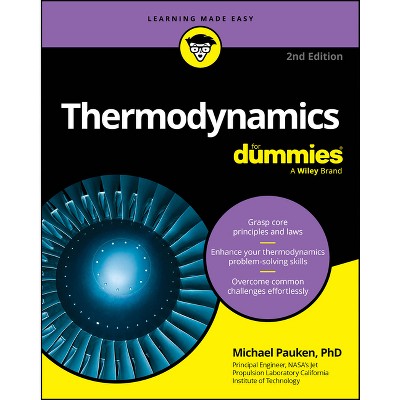About this item
Highlights
- Thermodynamics is the science that describes the behavior of matter at the macroscopic scale, and how this arises from individual molecules.
- About the Author: Professor Bill Poirier, Department of Chemistry & Biochemistry, Texas Tech University, USAProfessor Poirier is Professor of Chemistry and Biochemistry and Joint Professor of Physics at Texas Tech University, where he has held research positions since 2001.
- 192 Pages
- Science, Mechanics
Description
Book Synopsis
Thermodynamics is the science that describes the behavior of matter at the macroscopic scale, and how this arises from individual molecules. As such, it is a subject of profound practical and fundamental importance to many science and engineering fields. Despite extremely varied applications ranging from nanomotors to cosmology, the core concepts of thermodynamics such as equilibrium and entropy are the same across all disciplines.
A Conceptual Guide to Thermodynamics serves as a concise, conceptual and practical supplement to the major thermodynamics textbooks used in various fields. Presenting clear explanations of the core concepts, the book aims to improve fundamental understanding of the material, as well as homework and exam performance.
Distinctive features include:
- Terminology and Notation Key: A universal translator that addresses the myriad of conventions, terminologies, and notations found across the major thermodynamics texts.
- Content Maps: Specific references to each major thermodynamic text by section and page number for each new concept that is introduced.
- Helpful Hints and Don't Try Its: Numerous useful tips for solving problems, as well as warnings of common student pitfalls.
- Unique Explanations Conceptually clear, mathematically fairly simple, yet also sufficiently precise and rigorous.
A more extensive set of reference materials, including older and newer editions of the major textbooks, as well as a number of less commonly used titles, is available online at http: //www.conceptualthermo.com.
Undergraduate and graduate students of chemistry, physics, engineering, geosciences and biological sciences will benefit from this book, as will students preparing for graduate school entrance exams and MCATs.From the Back Cover
A Conceptual Guide to Thermodynamics
Bill Poirier
Department of Chemistry and Biochemistry, Department of Physics, Center for Chemical Biology
Texas Tech University, USA
Thermodynamics is the science that describes the behavior of matter at the macroscopic scale, and how this arises from individual molecules. As such, it is a subject of profound practical and fundamental importance to many science and engineering fields. Despite extremely varied applications ranging from nanomotors to cosmology, the core concepts of thermodynamics such as equilibrium and entropy are the same across all disciplines.
A Conceptual Guide to Thermodynamics serves as a concise, conceptual and practical supplement to the major thermodynamics textbooks used in various fields. Presenting clear explanations of the core concepts, the book aims to improve fundamental understanding of the material, as well as homework and exam performance.
Distinctive features include:
- Terminology and Notation Key: A universal translator that addresses the myriad of conventions, terminologies, and notations found across the major thermodynamics texts.
- Content Maps: Specific references to each major thermodynamic text by section and page number for each new concept that is introduced.
- Helpful Hints and Don't Try Its: Numerous useful tips for solving problems, as well as warnings of common student pitfalls.
- Unique Explanations Conceptually clear, mathematically fairly simple, yet also sufficiently precise and rigorous.
A more extensive set of reference materials, including older and newer editions of the major textbooks, as well as a number of less commonly used titles, is available online at http: //www.conceptualthermo.com.
Undergraduate and graduate students of chemistry, physics, engineering, geosciences and biological sciences will benefit from this book, as will students preparing for graduate school entrance exams and MCATs.Review Quotes
"Useful for students and professionals in numerous areas, including biology, chemistry, physics, and engineering. . . Summing Up: Recommended. Upper-division undergraduates and above." (Choice, 1 April 2015)
About the Author
Professor Bill Poirier, Department of Chemistry & Biochemistry, Texas Tech University, USA
Professor Poirier is Professor of Chemistry and Biochemistry and Joint Professor of Physics at Texas Tech University, where he has held research positions since 2001. His research is concerned with the development and application of new methods for performing accurate quantum dynamics calculations with unprecedented computational efficiency, to allow calculations for larger systems than ever before. This has wide ranging applications in areas including astrophysics, environmental, atmospheric and combustion chemistry, materials, and hydrogen storage.
Professor Poirier has extensive teaching experience at undergraduate and graduate level, teaching undergraduate courses in general chemistry and physical chemistry, and graduate courses in chemical kinetics, molecular spectroscopy and statistical mechanics.
Shipping details
Return details
Trending Non-Fiction












